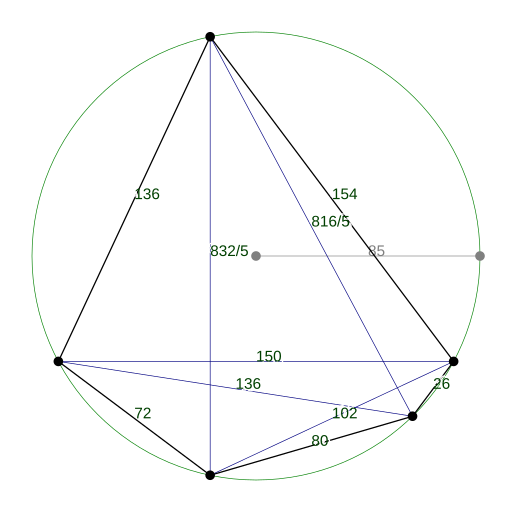In geometry, a Robbins pentagon is a cyclic pentagon whose side lengths and area are all rational numbers.
History
Robbins pentagons were named by Buchholz & MacDougall (2008) after David P. Robbins, who had previously given a formula for the area of a cyclic pentagon as a function of its edge lengths. Buchholz and MacDougall chose this name by analogy with the naming of Heron triangles after Hero of Alexandria, the discoverer of Heron's formula for the area of a triangle as a function of its edge lengths.
A Robbins pentagon with area of 13,104
A Robbins pentagon with area of 7392Area and perimeter
Every Robbins pentagon may be scaled so that its sides and area are integers. More strongly, Buchholz and MacDougall showed that if the side lengths are all integers and the area is rational, then the area is necessarily also an integer, and the perimeter is necessarily an even number.
Diagonals
Buchholz and MacDougall also showed that, in every Robbins pentagon, either all five of the internal diagonals are rational numbers or none of them are. If the five diagonals are rational (the case called a Brahmagupta pentagon by Sastry (2005)), then the radius of its circumscribed circle must also be rational, and the pentagon may be partitioned into three Heron triangles by cutting it along any two non-crossing diagonals, or into five Heron triangles by cutting it along the five radii from the circle center to its vertices.
Buchholz and MacDougall performed computational searches for Robbins pentagons with irrational diagonals but were unable to find any. On the basis of this negative result they suggested that Robbins pentagons with irrational diagonals may not exist.
References
Buchholz, Ralph H.; MacDougall, James A. (2008), "Cyclic polygons with rational sides and area", Journal of Number Theory, 128 (1): 17–48, doi:10.1016/j.jnt.2007.05.005, MR 2382768.
Robbins, David P. (1994), "Areas of polygons inscribed in a circle", Discrete and Computational Geometry, 12 (2): 223–236, doi:10.1007/BF02574377, MR 1283889
Robbins, David P. (1995), "Areas of polygons inscribed in a circle", The American Mathematical Monthly, 102 (6): 523–530, doi:10.2307/2974766, MR 1336638.
Sastry, K. R. S. (2005), "Construction of Brahmagupta n-gons" (PDF), Forum Geometricorum, 5: 119–126, MR 2195739.
Undergraduate Texts in Mathematics
Graduate Studies in Mathematics
Hellenica World - Scientific Library
Retrieved from "http://en.wikipedia.org/"
All text is available under the terms of the GNU Free Documentation License



